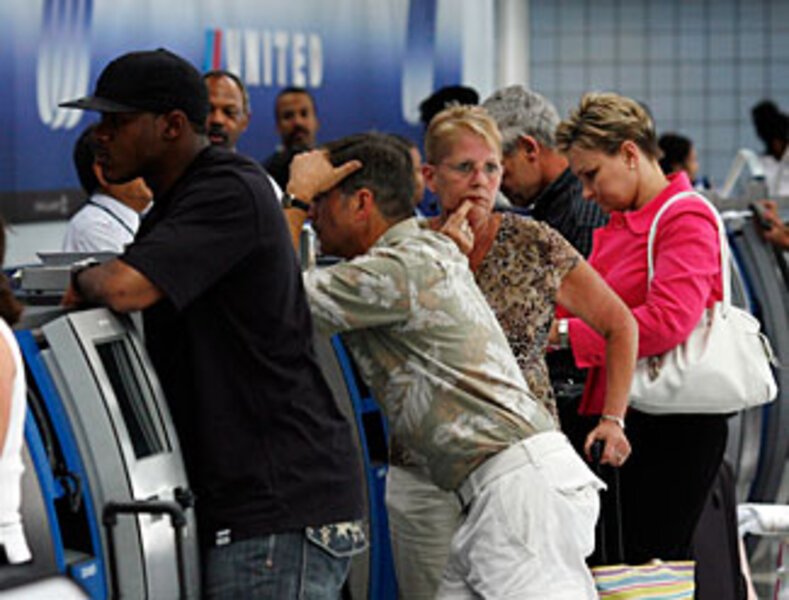Losses loom for airlines, but most can stave off bankruptcy – for now
Loading...
| New York
Though some airlines are slashing fares to lows not seen since the mid 1990s, many Americans still aren't flying.
In June, passenger traffic among the largest airlines plummeted from the same time last year. United Airlines led the pack with a drop of 10 percent.
That's prompting analysts to predict losses across the board when airlines post second-quarter earnings later this month. But few are predicting a rush toward bankruptcy court, at least not in the near future. That's because load factors – or how full a plane is – are up as airlines have sharply reduced the number of flights.
As long as oil prices don't rise again suddenly, most airlines are expected to limp along, economically, toward the end of the year.
"If I had to make a choice, I'd say you won't see any bankruptcies before the fourth quarter of this year," says Robert Herbst, an analyst at AirlineFinancials.com. "The traffic demand, even though the fares are low, seems high enough so they'll have enough cash flow to keep going on through the summer. That could change drastically in the wintertime."
That's because people don't fly as much in the fall and winter, except on holidays. So the challenge is: How do airlines increase revenues or cut costs enough to keep the cash flowing? Most have already slashed costs since the boom times of the late 1990s. As an industry, airlines have laid off 150,000 people since 9/11 and cut remaining workers' pay and benefits. In 2008, "operating revenues … were around $3 billion more than year 2000. Over the same time period, employee wage/benefits dropped by nearly $6 billion," Mr. Herbst wrote in a recent commentary on AirlineFinancials.com.
The airlines already are operating with just enough employees to stay open, some analysts say (but not enough, many travelers complain, to get the baggage off-loaded in a timely manner). So the next option is the fare sale, like the one Southwest kicked off this week that offers one-way tickets as low as $30 on some routes.
That can bring in cash in the short term, but not enough to support the airlines' current fixed costs, especially if oil prices rise again. What airlines need, say some analysts, is for the business community – which traditionally pays much higher fares – to start traveling as much as it used to. Some say that will happen when the economy recovers. But others contend that business travel will not recover, at least not to previous levels.
"This current economic malaise is a game-changer in terms of corporate psychology," says Kevin Mitchell, chairman of the Business Travel Coalition in Radnor, Pa. "And it's not just the economy. It's the recklessness on Wall Street, it's the fund abuse – all of these things are being rolled together in the boardroom, and it's going to prompt a permanent psychological change in terms of how these companies view travel and what's acceptable. I don't think it's going to come back to the heydays of a few years ago."
Mr. Mitchell and analyst Herbst both conclude that the American traveler may soon have to adjust to higher overall airfares.
"[A]fter reviewing airline industry financials, it is obvious air fares are simply too low to support the ongoing fixed and variable costs of one of this country's most important business sectors," Herbst wrote. "Safety, schedule reliability and customer service come at a price. These should not be compromised for cheap fares."
------
Follow us on Twitter.





